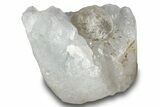This Specimen has been sold.
1.9" Botryoidal Fluorite on Quartz/Amethyst - India
This is a unique formation of fluorite that was collected from Kalagwani, India. It formed in botryoidal fashion and is naturally associated with chalcedony, quartz, and amethyst crystals.
About Botryoidal Fluorite From India
Botryoidal fluorite from Madhya Pradesh, India forms smooth, grape-like mounds of translucent yellow to yellow-brown fluorite draped over a sparkling bed of quartz and amethyst crystals. The fluorite grows in rounded hemispheres made of tightly packed, radiating micro-crystals, giving the surface a softly glossy, almost waxy sheen that contrasts beautifully with the sharp, glassy faces of the underlying quartz points and purple amethyst tips.
These specimens typically come from localities such as Tekhdi and Khadakwadi in Madhya Pradesh, where mineral-rich fluids filled cavities in volcanic or sedimentary rocks and deposited successive layers of fluorite and silica. As conditions shifted, amethystine quartz lined the cavity first, followed by botryoidal fluorite that coated the geode walls and sometimes bridges across the opening. The result is an eye-catching combination piece: warm botryoidal fluorite “bubbles” perched on a vivid amethyst and quartz matrix, prized both for its rarity and striking color contrast.
Botryoidal fluorite from Madhya Pradesh, India forms smooth, grape-like mounds of translucent yellow to yellow-brown fluorite draped over a sparkling bed of quartz and amethyst crystals. The fluorite grows in rounded hemispheres made of tightly packed, radiating micro-crystals, giving the surface a softly glossy, almost waxy sheen that contrasts beautifully with the sharp, glassy faces of the underlying quartz points and purple amethyst tips.
These specimens typically come from localities such as Tekhdi and Khadakwadi in Madhya Pradesh, where mineral-rich fluids filled cavities in volcanic or sedimentary rocks and deposited successive layers of fluorite and silica. As conditions shifted, amethystine quartz lined the cavity first, followed by botryoidal fluorite that coated the geode walls and sometimes bridges across the opening. The result is an eye-catching combination piece: warm botryoidal fluorite “bubbles” perched on a vivid amethyst and quartz matrix, prized both for its rarity and striking color contrast.
SPECIES
Fluorite, Quartz var. Chalcedony & Quartz var. Amethyst
LOCATION
Kalagwani, Burhanpur District, Madhya Pradesh, India
SIZE
Entire specimen: 1.9 x 1.6", Fluorite: .7" wide
CATEGORY
ITEM
#244497
 Reviews
Reviews













